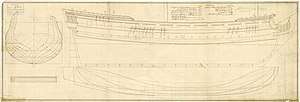HMS Sheerness (1743)
HMS Sheerness was a 24-gun sixth rate frigate of the Royal Navy launched in 1743. Commanded by Captain O'Brian, she served on patrol duties in the North Sea during the 1745 Jacobite Rising.
 Sheerness | |
| History | |
|---|---|
| Name: | HMS Sheerness |
| Ordered: | 7 January 1743 |
| Builder: | John Buxton, Snr, Rotherhithe |
| Laid down: | 24 January 1743 |
| Launched: | 8 October 1743 |
| Completed: | By 19 November 1743 |
| Fate: | Sold on 26 July 1768 |
| General characteristics | |
| Class and type: | 24-gun sixth rate frigate |
| Tons burthen: | 508 69⁄94 bm |
| Length: | |
| Beam: | 32 ft 1 in (9.78 m) |
| Depth of hold: | 11 ft (3.4 m) |
| Sail plan: | Full rigged ship |
| Complement: | 140 (160 from 1745) |
| Armament: |
|
In November 1745, she captured a French ship carrying supplies to Montrose, along with a number of Jacobite officers. They included Charles Radclyffe, de jure Earl of Derwentwater, who was executed at Tower Hill on 8 December 1746.[1]
In the Skirmish of Tongue on 26 March 1746, Sheerness chased the Jacobite Le Prince Charles, formerly HMS Hazard, into the Kyle of Tongue. Its crew disembarked, taking with them £13,000 in gold intended to help finance the Rising, but were intercepted and forced to surrender by government militia.[2]
During the Seven Years' War, she captured the French merchant-ship Auguste off Spain on 18 August 1756; sold to British merchants and renamed 'Augusta', it was wrecked carrying French passengers returning from Quebec to France in 1761.[3]
She was sold in 1768.
References
- Secombe & 1896, DNB.
- Mackay 1906, pp. 190-191.
- "SV Augusta (ex-Auguste)". Wrecksite.eu. Retrieved 7 December 2019.
Sources
- Mackay, Angus (1906). The Book of Mackay. Norman MacLeod.CS1 maint: ref=harv (link)
- Secombe, Thomas (1896). Dictionary of National Biography, 1885-1900, Volume 47. Radcliffe, James (Charles sub-section): Smith, Elder & Co.CS1 maint: ref=harv (link)
External links

- "SV Augusta (ex-Auguste)". Wrecksite.eu. Retrieved 7 December 2019.